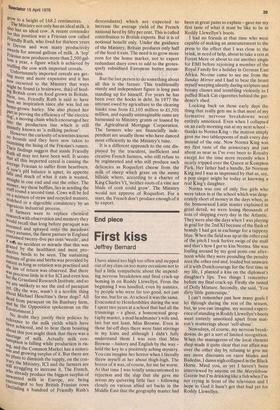Country life
Friendly Ruth
Patrick Marnham
The way They Manage the milk is inter' esting and becoming more so. As we are frequently reminded, no other 'dairy Indus' try' provides such a splendid range of choice as ours, five grades of milk, five of cream' and all delivered to the door each morning'
It is not quite like that out in the milk country. Here there are cows on all sides, their gurt-swollen udders brushing the bYbrid grass (and hanging too low for their own calves to reach), but milk is a scarce conr modity. If you live beyond town limits II° one wants to deliver it, and when you d°„ persuade a man to call he does not se" cream or gold top. Well, well, minorities must not complain, that is not the front.ter spirit, and anyway there is a surprisnig amount of nourishment to be had from a1' of Coffeemate.
And, by chance, there has until now be an alternative. A nearby farmer, Nir.s George, sells unpasteurised farm milk, We despised sixth grade, which is the best yod can buy. But the Ministry does not approve., of this. And by 1980 (four years early) the intend to 'phase out' farm milk altogether' In future ze milk vill be ze same everyvere: zey vill drink ze same amount, und ve villa!'
grow to a height of 168.2 centimetres.
, The Ministry not only has an ideal milk, it !is° has an ideal cow. A recent contender 'or this position was a Friesian cow called !riendly Ruth, who lived for thirteen years in Devon and won many productivity awards for annual gallons of milk. A 'top' Friesian now produces more than 2,500 gal Inns a year, a figure which is achieved by stuffing the cow with imported cereals. . Unfortunately imported cereals are get44 more and more expensive and it has /19w occurred to the Ministry that ways !night be found (a brainwave, this) of feed„lag British cows on food grown in Britain. ttere, too, Friendly Ruth is said to have h'een an inspiration since she was fed on "unie-grown barley. She also played her
art flproving the efficiency of 'the electric
g, a moving chain which encouraged her tutu. the production line which is still cill,antfly known as 'a milking parlour'. klowever the curiosity of scientists knows nu bounds and they have now taken to .eamining the lining of the Friesian's rumen.
ileir findings suggest that inside Friendly th all may not have been well. It seems
at all this imported cereal is causing the average Friesian to suffer from heartburn.
euw's pH balance is upset, its appetite
ails and much of what it eats is wasted, straight in one end and out the other. The answer, say these boffins, lies in sending the stuff round a second time. Cows will be fed
Mixture of straw and recycled manure,
ulched to a digestible consistency by an ingenious industrial process. ff farmers were to replace chemical research with observation and memory they w. °It'd recall that long before paraquat was Invented and sprayed onto the meadows every autumn, the finest pasture in England tamed twenty-five per cent 'weeds', and it Mrs no accident or miracle that this was gdrazed by the healthiest and most pro enve herds to be seen. The sustaining ,;"ucture of grass and herbs was provided by ;',_ature as long as rotation was practised and 'fie law of return was observed. But there w, as precious little in it for ICI and even less
"nr the Grassland Research Institute, and so we are unlikely to see the end of paraquat
ylt. (By the way, wasn't it a terrible thing
Llt Michael Heseltine's three dogs? All
fiead from paraquat on his Banbury farm, t,and .he the Opposition spokesman on the 4-nvironment.) No doubt they justify their policies by illeference to the milk yields which have °ten achieved, and to hear them boasting abt this you might think that there was a ashou°rtage of milk. Actually milk con.umption is falling while production is ris,Ing, and the Common Market has a notori7.u5 and growing surplus of it. But there are ° Plans to diminish the supply, on the conLa. rY the Ministry, ICI and the farmers are struggling to increase it. The French, who already produce the biggest surplus of unwanted milk in Europe, are being eoncouraged to buy British Friesian cows \Including a hundred of Friendly Ruth's
descendants) which are expected to increase the average yield of the French national herd by fifty per cent. This is called contribution to British exports. But it is of notional benefit only. Under the guidance of the Ministry, Britain produces only half of the food it eats. The need is to grow more corn for the home market, not to export redundant dairy cows to add to the grotesquely subsidised European butter mountain.
But the last person to do something about all this is the farmer. This traditionally sturdy and independent figure is long past standing up for himself. For years he has been over the hocks in debt. In 1977 the amount owed by agriculture to the clearing banks rose from £1,103 million to £1,501 million, and equally unimaginable sums are harnessed to Ministry grants or loaned by the Agricultural Mortgage Corporation. The farmers who are financially independent are usually those who have danced most efficiently to the Ministry's tune.
It is a different approach to the one displayed by the truculent, inefficient and creative French farmers, who still refuse to be regimented and who still produce such delicacies as Roquefort cheese from the milk of sheep which graze on the sunny hillside where, according to a charter of King Charles VI, 'neither roots of a vine nor blade of corn could grow'. The Ministry would not approve of Roquefort. For a start, the French don't produce enough of it to export.



































 Previous page
Previous page